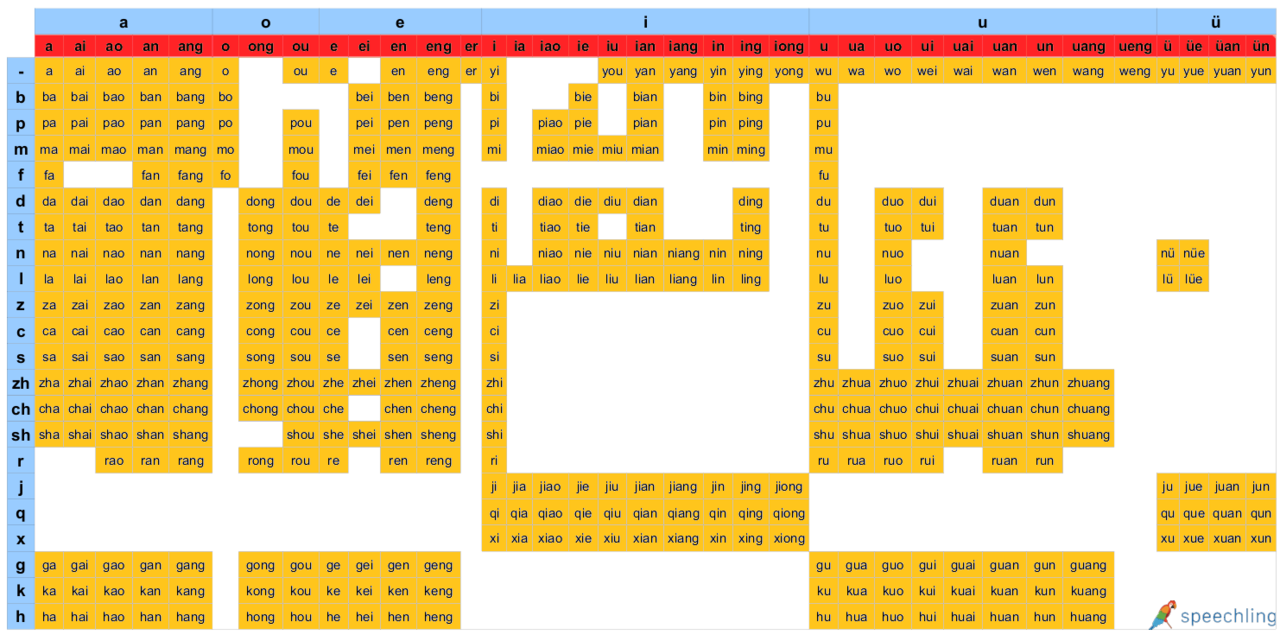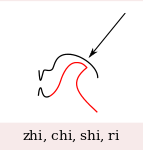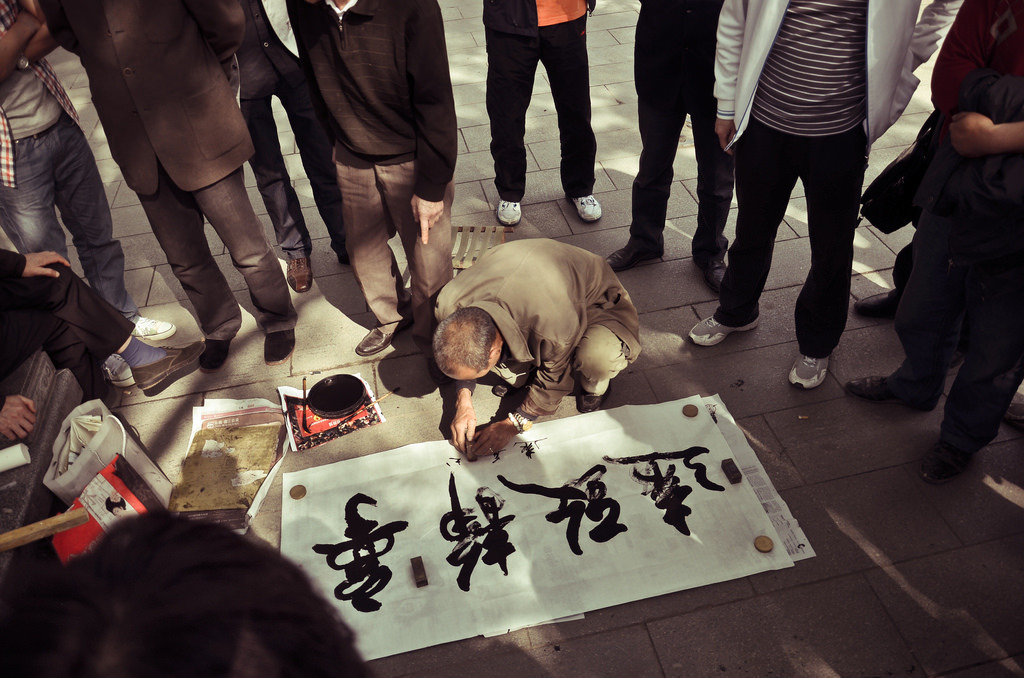How to Speak Chinese - The Ultimate Guide to Chinese Pronunciation

Regardless of whether you have or haven’t started learning Chinese, you’ve probably heard that it’s one of the (if not THE) hardest languages in the world to learn. This is especially true when it comes to speaking. However, despite what you may have heard about how it uses tones, or how so many of the sounds are the exact same (it’s like homophone insanity to a tone deaf listener), it's not as hard as you might think.
Sure, it takes some time to get used to the language’s new rules and methods for pronunciation, but it’s not impossible. Moreover, there couldn’t be a better time to get ahead of the competition and start learning this incredibly useful language. With China’s economy booming and its businesses extending around the world, if you have the grit and determination to pick it up, it’s going to open a lot of doors for you.
This guide aims to get you more than started by going over the basics of pronunciation, including tone, what’s called Pinyin, and a couple of ways to get yourself practising your ability to communicate in Mandarin Chinese.
Think of Chinese like sailing. It looks hard, it looks complicated, but once you've got the basics down, the rest of it seems to just fall into place. As long as you know where you're going, you should be fine.
So, if you want to be conversational (with a Chinese native speaker and not a computer program), this guide aims to help you find a good ship, teach you about the different parts, and get you sailing to your destination.
 Come Sail Away!
Come Sail Away!
What this Guide is Not about
This guide is not about making your Chinese as good as a native’s. That is an incredibly long and arduous journey. Instead, this guide is all about learning to speak with the aim of communication; of being able to make yourself heard and understood clearly.
Don’t expect complex grammar introductions or deep dives into semantic theories. Especially, don’t expect a guide on how to tackle the Chinese writing system – that’s another topic entirely and one we don’t have time for here. There will be Chinese characters used to help with examples, but don’t’ expect us to tell you how to write them yourself. You can find that elsewhere on the internet.
So, without further ado, and if you’re ready to get started and put the time in, let’s get speaking Mandarin Chinese!
 I had to make the Mandarin Orange Joke at some point, right?
I had to make the Mandarin Orange Joke at some point, right?
Pinyin: The Sounds of Mandarin Chinese
The first thing you're going to need to know about before we proceed any further is Pinyin. Did you know that there are two ways to write Mandarin Chinese?
你好
Nǐ hǎo (Hello)
Notice the version which isn't Chinese Characters (or English)? That is what is called Pinyin. It's essentially the same as the Latin Script found in English, except it's got a few extra marks and dashes.
But if Chinese has its own writing system (the first part), why do they have a writing system like English? Well, the reason is that it’s an easier way to phonetically understand Mandarin Chinese before learning any of its characters. This includes for Chinese natives learning the language when they're children.
For the purpose of this article, we’re going to use Pinyin when we refer to sounds. The Pinyin we're looking at follows the guidelines of the HSK test. Have a look below for a chart of all the Pinyin Sounds available.
Oh, and the dashes and lines over the top of some of the letters? Those are tone indicators. Don't worry, that's something we will get to later.
How Many Sounds in Chinese?
There’s a bit of an argument over how many sounds there actually are in Mandarin Chinese. However, it’s safe to say that the number -
without tones - is around 410. With tones it’s around 1200; give or take a little bit.
That might seem like a lot of different sounds to learn, but it’s not actually too bad. Pinyin can be divided into two parts. The first part is Initials (the beginning of sounds), whilst the second part is known as Finals (surprisingly, the part at the end of sounds).
So that we don't have to cover 410 sounds, we're going to work on covering all of the Initials and Finals separately. Then we can work on bringing them together.
As a side note, each sound can have up to 60 different characters or meanings associated with it. Meaning learning the sounds is just the first step.
 The complete list of Pinyin sounds - complete with parrot colours
The complete list of Pinyin sounds - complete with parrot colours
How to Pronounce Pinyin Initials
There is a total of 21 initials in Mandarin Chinese Pinyin. For the most part, their sounds are similar to the sounds you would expect to hear in English. There are, however, a few which do diverge quite significantly. Check below for a full list and how to pronounce them correctly.
b – Like ‘b’ in ‘bat’
变化 Biàn (Change)
请你重复一遍好吗?
qǐng nǐ chóng fù yī biàn hǎo má ? (Can you repeat that please)
The same as in English.
p – Like ‘p’ in ‘pants’
朋友 péng yǒu (friend)
Example #1:
你朋友是中国人吗?
nǐ péng yǒu shì zhōng guó rén má ? (Is your friend Chinese)
The only difference between the English and Chinese pronunciation of this sound is that in Chinese ‘p’ should be voiced. Meaning it should be louder.
m – Like ‘m’ in ‘mat’
马 mǎ (horse) 妈 mā (mother)
Example #1:
你知道这是说的什么吗?
nǐ zhī dào zhè shì shuō de shén me má? (Do you know what this says)
The same as in English.
f – Like ‘f’ in ‘fat’
发 fā (send) 头发 tóufǎ(hair)
Example #1:
我想发一份传真。
wǒ xiǎng fā yī fèn chuán zhēn 。(I'd like to send a fax)
Again, the same as it is in English.
d – Like ‘d’ in ‘dad’
的 de (possessive marker) 你的 nǐ de (your)
Example #1:
你的钱够吗?
nǐ de qián gòu má ?(Do you have enough Money)
Keep up those English Phonics! Similar to English but shouldn’t be voiced as much. This means it should sound softer; almost like you're whispering the 'd' in dad. Check your vocal chords in your throat to see if they’re vibrating.
t – Like ‘t’ in ‘tat’
条路 Tiáo lù(Way)
Example #1:
这条路通向那儿吗?
zhè tiáo lù tōng xiàng nà ér má ? (Does this road go there)
Need I say it again? Stick to the English Pronunciation.
n – like ‘n’ in ‘nan’
那儿 (there) 哪儿 (where)
Example #1:
这条路通向那儿吗?
zhè tiáo lù tōng xiàng nà ér má ? (Does this road go there)
We're using the same example again because if it ain't broke, don't fix it. Moreover, nà ér might be one of the more common uses of 'n' you'll use in Mandarin Chinese.
To make this sound correctly, simply stop your vocal chords from vibrating as ‘n’ shouldn’t be as voiced like its English counterpart is. Basically, it’s not as forced and sounds softer - just like 'd' above.
l – Like ‘l’ in ‘like’
来 lái (come)
Example #1:
我稍后会回来。
wǒ shāo hòu huì huí lái 。 (I'll come back later)
Same as the English version.
g – Like a Soft 'g' in 'get'
跟 gēn (with)
Example #1:
跟我走。
gēn wǒ zǒu 。 (Follow me)
'g' is similar to its English counterpart, but you'll want to make sure it's just a little bit softer in Mandarin pronunciation. This is because in Mandarin, 'g' isn't voiced like it is in English.
k - Like a Soft 'k' in 'kit'
考试 kǎoshì (test) 思考 sīkǎo (thinking)
她想要通过考试吗?
tā xiǎng yào tōng guò kǎo shì má ? (Does she want to pass the test)
'k' should also be unvoiced, just like 'g'. This can be tricky because you should be feeling a puff of air escape your mouth when you pronounce 'k'. Try starting the sound in your mouth, not your throat.
h - Like a Hard 'h' in 'huh?'
好 hǎo (good)
Example #1:
你好!
nǐ hǎo! (Hello)
'h' is a bit different than 'g' and 'k' above because it does the opposite. Whilst they should be softer in Mandarin Chinese pronunciation, 'h' should actually be harsher. Imagine that something has surprised you and all you can say is 'huh?' in a rather force tone. You'll get it in no time!
x - Like a Soft 'sh' in 'sheet'
西 Xī (west) 谢谢 xièxiè (thank you)
Example #1:
很高兴见到你!
hěn gāo xìng jiàn dào nǐ!(Nice to meet you)
To make the 'x' sound, arrange your mouth as though you were about to make the 'sh' sound in English, and then lower your tongue to behind your bottom set of teeth. It'll take a bit of practice but you'll get there in the end.
q - Like a Mandarin 'x' But With a 't' First
钱 Qián (Money) 天气 tiānqì (Weather)
Example #1:
这要花费多少钱?
zhè yào huā fèi duō shǎo qián ?(How much does this cost)
Begin by making sure that you've got your 'x' pronunciation down, then place a 't' sound in front of it. Tada, you are now saying the 'q' sound.
Top Tip For 'q'. A lot of resources say that 'q' sounds the same as 'ch' in English. It doesn't. Your tongue should be that extra little bit more forward and touching your bottom set of teeth.
j - Again With Your Tongue Down
叫 jiào (call) 教 jiào (teach) 见 jiàn (see)
Example #1:
你家什么名字?
nǐ jiào shén me míng zì ? (What is your name)
Same as with 'x' above, make sure to position your tongue behind your lower set of teeth and then try to pronounce the English 'j'.
zh - Like 'J' in 'Juice'
知道 Zhīdào (Understand)只 zhǐ (Only/ measure word for animals)
Example #1:
祝好运!
zhù hǎo yùn (Good luck)
The 'zh' sound is similar to the 'j' sound in English. However, you'll have to make sure that you bring your tongue up to the roof of your mouth. Follow the diagram below and you'll find yourself zhīdào-ing (understanding) in no time!

How to position your tongue
ch - With A Tongue Curl
吃 Chī (eat) 车 chē (car)
Example #1:
一张单程票。
yī zhāng dān chéng piào 。 (A one way ticket)
Similar to 'Zh' above, pronouncing 'Ch' correctly means curling your tongue towards the roof of your mouth. Make sure to touch the roof with the tip of your tongue, and then let a small gap appear when you let the air escape.
sh - Like 'shhh' With A Forced Lisp
十 Shí(ten) 蛇 shé (snake) 什么 shénme(what)
Example #1:
生日快乐!
shēng rì kuài lè !(Happy Birthday)
Let's give happy birthday a go, this time focusing on the 'sh' sound. It couldn't be easier. Curl your tongue towards the roof of your mouth, but leave a small gap. Then make the 'be quiet' sound you might have been so used to hearing when you were a child. What you're hearing should be the initial 'sh'.
r - Like the 'rrrrrr' in 'brrrrrrrr'
日 rì (day) 热 rè (hot)
Example #1:
生日快乐!
shēng rì kuài lè !(Happy Birthday)
'R' is one of the most difficult and elusive of Mandarin Chinese sounds. In fact, in many parts of China, the sound isn't pronounced correctly and instead seems more like a 'l' sound.
The Trick is to try pronouncing 'r' as you would in English, then curling the tip of your tongue back slightly, until the flow of air is just slightly stopped. You should notice the difference, as though you were speaking with something in your mouth.
c – Like the ‘ts’ in ‘bits’
菜Cài (dish) 猜 cāi (guess) 参加 cānjiā (join / participate)
Example #1:
从这儿到那儿。
cóng zhè ér dào nà ér。 (From here to there)
'c' is a strange sound because it’s so different from English. Many of the other initial sounds actually have at least some level of similarity with their English counterparts, 'c' does not. If you want to pronounce 'c', make sure that the tip of your tongue touches the back of your bottom set of teeth and then say the 'ts' from 'bits'.
z - Like 'ds' in 'kids'
早 zǎo (early) 在 zài (at)
Example #1:
他的父母住在纽约。
tā de fù mǔ zhù zài niǔ yuē。 (His parents live in New York)
The 'z' sound in Chinese is also quite different than it is in English. It actually sounds more like a 'ds' sound. Just like with the 'ts' above, 'ds' is only ever found at the tail end of English words, not in the beginning. Just get used to this and you'll be fine in no time.
s - Like 's' in 'super easy!'
思考 sīkǎo (thinking)
Example #1:
他在思考。
tā zài sī kǎo 。(He thinks)
's' is identical to its English counterpart.
Common Chinese Initial Mistake #1: Your Tongue is Important
One mistake many beginners make is that of the importance of the tongue. Tongue position is incredibly important in Mandarin Chinese. Make sure that your tongue is placed either towards the front of your mouth near your bottom set of teeth, or brought up towards the roof of your mouth.
Try giving some Chinese tongue twisters a go if you want to really practice your tongue movement.
Common Chinese Initial Mistake #2: Voiced and Unvoiced
Voiced and unvoiced sounds concern how and to what degree you use your throat to create a sound. Generally, Chinese sounds are 'unvoiced', meaning that they come out a little softer than their English counterparts. To check, put your hand on your throat and see if it's vibrating or not when you speak. If it's vibrating, you've 'voiced' a sound.
'ch', 'zh' and 'sh' are great examples of voiced sounds in Chinese.
 Only another 36 sounds to go!
Only another 36 sounds to go!
How to Pronounce Pinyin Finals
There are 36 finals in Mandarin Chinese Pinyin. However, the following list will only include 32. The reason for this is that the 4 which are not being covered are used so infrequently that it's incredibly unlikely you will ever hear them. Not until you're a very advanced Mandarin Chinese speaker. Even then, in fact, it’s somewhat unlikely.
Whilst pronouncing the Finals below, try to practice combining them with different Initials. Remember, Mandarin Chinese is like sailing. you need to control the rudder, the sails, and the crew in order to stay on course!
a - Like 'ah' in 'ah hah!'
爸爸 bàba (father) 卡 kǎ (card)
Example #1:
你爸爸在家吗?
nǐ bà bà zài jiā má ? (Is your father at home)
Pretty simple, keep your pronunciation the same as 'ah' in English and you'll be having that eureka moment before you know it!
ai - Like 'eye' in 'eye'
爱 ài (love) 白 bái (white)
Example #1:
她爱他吗?
tā ài tā má ? (Does she love him)
Relatively simple due to its similarity with English. Just try pronouncing 'eye', or 'aye' as though you were a pirate (without the gruff tone of voice of course).
ao - Like 'ou' in 'proud'
包 bāo (bag)
Example #1:
在你的包包里。
zài nǐ de bāo bāo lǐ 。(It's in your bag)
A bit different, but not by too much. Try isolating the 'ou' sound in 'proud' or 'sour' and pronouncing that on its own.
an - Like 'an' in 'man'
安全 ān quán (safe)
Example #1:
这地方安全吗?
zhè dì fāng ān quán má ?(Is this a safe area)
Just like in English.
ang - Like 'ah' in 'ah hah' and 'ng' in 'sing'
帮助 bāngzhù (help) 房子 fángzi (house)
Example #1:
我可以帮你吗?
wǒ kě yǐ bāng nǐ má ?(Can I help you)
You can make the 'ang' sound in Mandarin by combining the Mandarin Chinese 'a' sound with the same 'ng' sound you'll find in English.
o - Like 'o' in 'bore'
我 wǒ (I) 老婆 lǎopó (wife)
Example #1:
我喜欢。
wǒ xǐ huān 。(I like it)
To make the 'o' sound like a pro in Mandarin Chinese, you'll need to make the same shape as though you were saying the 'o' in 'bore'. Your tongue should be slightly curled, but not as much as with 'zh', 'ch', or 'sh'.
ong - Like 'ong' in 'song'
送 sòng (send)
Example #1:
谁送来的信?
shuí sòng lái de xìn ?(Who sent this letter?)
The same as it sounds in English.
ou - Like 'ou' in 'dough'
口 kǒu (mouth)
Example #1:
事故发生在十字路口。
shì gù fā shēng zài shí zì lù kǒu 。 (The accident happened at the intersection)
For a sound present in the word which means mouth, you won't have to open yours too wide to pronounce it properly. Try pronouncing 'ou' in words like 'dough', but make sure you don't pronounce the slight 'gh' sound which comes after.
e - Like 'uh' in 'duh'
饿 è (hungry)
Example #1:
我饿了。
wǒ è liǎo 。(I'm hungry)
'e' can be a tricky one in Chinese finals. It's not at all like the English 'e', which can put off beginners trying to master its pronunciation. It sounds a lot like 'uh'. Imagine having a stomach ache (maybe from hunger) and making that sound. You should have it down.
ei - Like 'ei' from 'eight'
北 běi (north)
Example #1:
在这里以北。
zài zhè lǐ yǐ běi 。(It's north of here)
'ei' might catch you by surprise, especially considering that all the other 'e' sounds in pinyin sound like 'uh'. 'ei' actually sounds like its English counterpart though. Try pronouncing 'ei' from 'eight'.
en - Like 'un' from 'sun'
门 mén (door)
Example #1:
银行什么时候开门?
yín háng shén me shí hòu kāi mén ?(When does the bank open)
Try pronouncing the 'un' sound from English, but this one isn't exactly the same. The sound should originate from the back of your mouth as opposed to in your throat, and your tongue should be slightly curved. It's almost as though it were a cross between the English 'en' and 'un'. It's somewhere in the middle.
eng - Like 'ung' from 'sung'
凤 fēng (wind)
Example #1:
风很大。
fēng hěn dà 。(It's very windy)
Similar to 'en'. Try pronouncing it as though you were making a sound somewhere between the English 'eng' and 'ung'. It is, however, closer to 'eng'.
er - Like 'ar' in 'bar'
儿子 ér zǐ(son)
Example #1:
问她有没有儿子--有,她有一个儿子。
wèn tā yǒu méi yǒu ér zǐ -- yǒu , tā yǒu yí gè ér zǐ 。(Ask if she has a son. Yes, she's got a son)
'er' sounds similar to 'ar' in English. It's another pirate sound, ya- har!
i - Like 'ee' in 'bee'
比 bǐ (compared to)
Example #1:
您比他聪明。
nín bǐ tā cōng míng 。(You're smarter than him)
'i' doesn't have the same short, sharp sound you expect in English, instead, it's a longer sound similar to 'ee'.
ia - Like 'ia' in 'iago'
家 jiā (home)
Example #1:
你爸爸在家吗?
nǐ bà bà zài jiā má ?(Is your father at home)
'ia' sounds pretty much the way you would expect a combination of the Mandarin Chinese 'i' and 'a' sounds together would. Make sure that middle of your tongue starts against the roof of your mouth, and then pushes off as you move to the 'uh' sounding 'a'.
iao - Like 'ee' in 'bee' and 'ou' in 'proud'
无聊 wú liáo (bored) 教 jiào (teach)
Example #1:
我感到无聊。
wǒ gǎn dào wú liáo 。(I'm bored)
Combine the Mandarin sounds of 'i' and 'ao' together to create this sound. Put more stress on the 'ao' sound.
ie - Like 'ee' in 'bee' and 'eh' in 'meh'
姐姐 jiě jiě (older sister)
Example #1:
我的姐姐是个农夫。
wǒ de jiě jiě shì gè nóng fū 。(My sister's a farmer)
Notice that the 'e' sound in 'ie' is slightly different than 'e' on its own. The pitch should be slightly higher.
After you've mastered this, the trick to pronouncing 'ie' correctly is to make sure that you stress the 'e' part. The 'i' should be relatively short and sweet, taken over by the 'e' sound quickly.
iu - Like 'ee' in 'bee' and 'ow' in 'bow'
丢 diū (lost)
Example #1:
他的电话丢失了。
tā de diàn huà diū shī liǎo 。(He lost his phone)
Whilst the 'i' sound remains the same, the 'u' sound is a bit different. Pronounce it as though you were trying to pronounce 'ow' in 'bow'.
ian - Like 'ee' in 'bee' and 'en' in 'ben'
见 jiàn (see)
Example #1:
对,下星期见。
duì , xià xīng qī jiàn 。(Yes, see you next week)
Similar to the longer 'i' forms above, make sure to stress the second sound of 'en' more than the 'i' sound.
iang - Like the Mandarin Chinese 'i' and 'ang'
讲 jiǎng (speak)
Example #1:
您讲得非常好。
nín jiǎng dé fēi cháng hǎo 。(You speak very well)
Just combine the Mandarin Chinese sounds of 'i' and 'ang'. Make sure to stress the 'i' sound, though.
in - Like 'in' in 'pin'
森林 sēn lín (forest)
Example #1:
我们参观了森林。
wǒ mén cān guān liǎo sēn lín 。(We visited the forest)
Nothing particularly surprising here. This is the same as it sounds in English.
ing - Like 'ing' in 'sing'
听 tīng (listen)
Example #1:
我没在听音乐。
wǒ méi zài tīng yīn yuè 。(I'm not listening to music)
Same as English. Enough said.
iong - Like 'ee' in 'bee' and 'ong' in 'kong'
游泳 yóu yǒng (swim) 熊 xióng (bear)
Example #1:
你会游泳吗?
nǐ huì yóu yǒng má ?(Can you swim)
Relatively rare when it comes to Pinyin sounds. You'll probably only come across 'iong' occasionally, but it's a good sound to be able to recognise regardless.
u - Like like 'oo' in 'spoon'
不 bù (no)
Example #1:
我不累。
wǒ bù léi 。 (I'm not tired)
Imagine you've just picked out that perfect outfit at the store. You're admiring it, and that unavoidable 'oo' escapes your mouth. That's the sound you should be making here, except it probably shouldn't last for as long.
Make sure that your lips are rounded and the sound originates closer to your throat than you might expect in English.
ua - Like 'wha' in 'whaaa?'
花 huā (flower)
Example #1:
你给我送花了吗?
nǐ gěi wǒ sòng huā liǎo má ? (Did you send me flowers)
Imagine making the (probably most frequently seen online) 'whaaa?' question and you've pretty much got the right sound for 'ua'. Make sure to remove the questioning tone though.
uo - Like 'w' and 'o'
火车 huǒ chē (train)
Example #1:
火车要来了吗?
huǒ chē yào lái liǎo má ? (Is the train coming)
Try pronouncing 'uo' as though ou were combining the English sounds of 'w' and 'o' together. It shouldn't sound like 'whoa' or 'woe'. This isn't a radical sadness!
Top Top! One of the most important words in Mandarin Chinese uses the sound of 'uo'. Can you guess what that is? That's right, it's 我 wǒ (I). Make sure that you can say it if you ever want to communicate anything about yourself.
ui - Like 'way'
对 duì (correct)
Example #1:
你是老师吗?--对,我是老师。
nǐ shì lǎo shī má ?-- duì , wǒ shì lǎo shī 。(Are you a teacher? -- Yes, I am.)
Again, the 'u' comes to sound a lot like a 'w' sounds in English. Say the English word 'way' and you'll have 'ui' down.
uai - Like 'why'
外面 wài miàn (outside)
Example #1:
外面在下雨。
wài miàn zài xià yǔ 。(It's raining)
Top Tip! The Pinyin 'wai' is pronounced in the exact same way you would expect the 'uai' sound to be pronounced on its own. You'll notice this on the Pinyin Chart towards the top of this article.
uan - Like 'w' and 'an'
段 duàn (segment)
Example #1:
你现在住在匹兹堡有一段时间了。
nǐ xiàn zài zhù zài pǐ zī bǎo yǒu yī duàn shí jiān liǎo 。(You've lived in Pittsburg for quite some time now)
Simply pronounce a typical English 'w' sound followed by 'an'. Make sure to stress the 'w' a bit more than you might have done before. Check the example for how it's done.
un - Like 'w' and 'n'
春假 chūn jià (Spring Break)
Example #1:
我们过了一个愉快的春假。他们呢?他们春假过得愉快吗?
wǒ mén guò liǎo yí gè yú kuài de chūn jià 。 tā mén ní ? tā mén chūn jià guò dé yú kuài má ?(We had a fun spring break. How about them? Did they have a fun spring break)
Similar to above, stress the 'w' sound a bit more when combining 'w' and 'an'.
uang - Like 'w' and 'ang'
黄油 huáng yóu (butter)
Example #1:
Derek和Irine在杂货店买黄油、牛奶和鸡蛋。
Derek hé Irine zài zá huò diàn mǎi huáng yóu 、 niú nǎi hé jī dàn 。(Derek and Irine were at the grocery store buying butter, milk, and eggs)
Derek might be buying eggs, but Irine knows how to say butter in Chinese. Combine an English 'w' in front of the chinese 'ang' and you'll also be able to.
Ü - Like 'oo' but different
旅行 lǚ xíng (travel)
Example #1:
我父亲只用过汽车旅行。
wǒ fù qīn zhī yòng guò qì chē lǚ xíng 。(My father's only traveled by car)
Purse your lips into a small circle and then move your tongue so that it touches the inside of your bottom lip. Finally, make an 'oo' sound. This strange version of 'oo' is the Mandarin Chinese sound of 'Ü'.
Top Tip! Unfortunately, most keyboards lack the 'Ü' key, so when writing 'Ü' in Chinese pinyin, the 'v' key tends to be used instead. For example, instead of 'lÜ', it's 'lv'.
Common Chinese Final Mistake #1: ‘Y’ is ‘I’
Yong is also pronounced with the 'iong' sound and not with the characteristic 'ya' 'y' sound. Take the sentence below as a prime example:
你会游泳吗?
nǐ huì yóu yǒng má ?(Can you swim)
Simply combine the Mandarin Chinese sounds of 'i' and 'ong'. It should sound like you're saying 'ee-yong'. Make sure to put more stress on 'ong' as it should dominate the sound.
Common Chinese Final Mistake #2: ‘U’ is ‘W’
When you start using 'u' in conjunction with other pinyin letters in finals, it tends to sound more like a 'w' sound in English. Because of this, when writing 'u' pinyin sounds on their own, they tend to be written with a 'w' at the beginning instead of a 'u'. Take a look at the chart above.

How to Speak Mandarin Chinese on the Word Level
So, you've managed to get the sounds down, now you're ready to start saying the tones. Remember, we talked about tones before; they are the little lines above some of the letters you see in Pinyin. In case you haven't noticed, there are 4 of them.
Every language, including English, actually already has tones, we just don't mark them. Think about it. How do you know someone is asking a question in English? They use a questioning tone. How do you show emotions in English? Tone.
However, there is a difference between tones in English and in Chinese, not least because[tones in Chinese are integral in generating meaning](https://en.wikipedia.org/wiki/Tone_(linguistics). In English, tone is not explicit - it is not taught directly as part of the language but inferred - in Chinese it is. Getting tones right can be the difference between saying something incredibly nice and flattering, and saying something which no one would want to be repeated here.

The Five Pinyin Tones.
Tone Tip #1. The 5th "Often Forgotten About" Tone. You might have noticed how some Pinyin words don't have a tone stroke attached to them. That's because it is essentially toneless. When you come to words like this, try to match its tone up with the sentence. If it's a 吗 (ma), it generally can be said as a second tone (upwards) as though it were a question. Regardless, make sure to keep a 5th tone short and sweet.
Tone Tip #2. Practice Tones in Pairs. Tones should almost always be practised in pairs and not on their own. Most Chinese words have two characters, so practising only one tone at a time can cause you to end up sounding like the automatic voice generator on your PC - it's not good and it's not natural.
As we go through the different tones you can speak, I'll give you some examples of words you can use to practice them in pairs. Good luck!

*Pinyin's 4 Tone Levels.*
The Tones of Chinese
1st Tone
The first tone might seem like it would be the easiest, but it can be a tricky one to master. You need to make your tone level and straight. A good trick is to think of tones in terms of 5 levels, just like in the image above. Whilst a lot of images put the 1st tone on the top level, try moving it down to the second to the top level if you're having a bit of difficulty. Give it a go.
飞机 fēijī (Plane)
中国 zhōngguó (China)
开始 kāishǐ (Start)
高兴 gāoxìng (Happy)
2nd Tone
The second tone is, for me personally, the hardest. It's especially difficult when it's followed by another tone. The trick is to not start right at the bottom, but from the middle and work your way up. Check the chart above.
明天 míngtiān (tomorrow)
学习 xuéxí (Study)
苹果 píngguǒ (Apple)
学校 xuéxiào (School)
Tone Tip #3. Don't Try and Make It Sound Like a Question. A lot of websites and articles say that you should try and make the 2nd tone sound like you were asking a question in English. Whilst this can be helpful in the beginning to understand the general gist of the 2nd tone, it causes problems down the line - especially when you combine it with another tone. Try listening to authentic samples, not English comparisons.
3rd Tone
The third tone is without a doubt the easiest. It stays pretty low and whilst the technically correct way to say it is by dipping slightly in your intonation, if you listen to Chinese Mandarin Native speakers, they rarely tend to do this. Normally, it is just a low, flat sound. brrrrr.
老师 lǎoshī (Teacher)
旅游 lǚyóu (Travel)
水果 shuǐguǒ (Fruit)
米饭 mǐfàn (Rice)
Tone Tip #4. Two Third Tones Make A Second. Keep in mind that if you have two third tones next to each other in a sentence, the first will nearly always change to a second tone. For example:
你 好 nǐ hǎo
becomes
你好 ní hǎo
4th Tone
As you can see above, the 4th tone is a direct downwards strike. It starts at the top and ends at the bottom. If you're finding it hard, try thinking about when you end a statement in English. What tone do you use? Normally, this is the 4th tone.
唱歌 chànggē (Sing a Song)
问题 wèntí (Question)
电影 diànyǐng (Movie)
电视 diànshì (TV Show)
Tone Tip #5. Start by Aiming Towards the Top, Don't Aim for the Bottom. A lot of guides say that it's best to start your intonation at the top and aim for the bottom. However, I have always found it a lot more useful to start by aiming towards the top. Think of it like a roller coaster just before its about to go over the tallest peak. You're about to go over but you still have a little bit further before you get there. Do the same with your voice when aiming for the 4th tone.

How to Speak Mandarin Chinese on the Sentence Level
Speaking Mandarin Chinese on the Sentence level is actually relatively easy. Luckily for language learners, there are no complicated conjugations (changes to verbs), no plural rules, and not much in the way of complex syntax.
In fact, a lot of Chinese people when asked will say that Chinese has no grammar. Whilst this obviously isn't true, it does stand to reason that the grammar is relatively simple and very versatile. Below is a crash course in the different levels of sentence structure you can expect to face when you set out speaking Chinese.
Basic Mandarin Chinese Sentence Structure
Subject --> Verb --> Object
I --> eat --> rice
我 wǒ --> 吃 chī --> 饭 fàn
Adding Time and Place (Example 1)
Subject --> Time --> Place --> Verb --> Object
I --> yesterday -->at the park --> ate --> rice
我 wǒ --> 昨天 zuótiān --> 在公园 zài gōngyuán --> 吃 chī --> 饭 fàn
Stressing Time Over Place (Example 2)
Time --> Subject --> Place --> Verb --> Object
Yesterday -->I --> at the park --> ate --> rice
昨天 zuótiān --> 我 wǒ --> 在公园 zài gōngyuán --> 吃 chī --> 饭 fàn
What you see above are some typical Mandarin Chinese sentence structures. Whilst the basic sentence structure might be the same as in English, it's pretty easy to mix things up once you start incorporating time and place.
If you're just starting out, it's usually best to stick to the first sentence structure which includes time and place (Example 1).
However,
If the time mentioned is about the duration of an action and not when it actually happened, it can go at the end of the sentence. For example:
English: I studied Chinese in China for four years.
Chinese: I, in China, studied Chinese for four years.
我在中国学中文四年了 Wǒ zài zhōngguó xué zhōngwén sì niánle
The "four years" in the sentence above is the duration of how long the speaker studied (sounds like he probably finished his bachelor’s degree). It is the duration of his study, it could have happened at any time even the future if he were some kind of psychic).
If we were, however, to say that he studied in in a certain year, say 2010, then we would have to put 2010 towards the beginning of the sentence:
Chinese: I, 2010 year, in China, studied Chinese.
我2010年在中国学中文. Wǒ 2010 nián zài zhōngguó xué zhōngwén.
Takeaway #1: Sentence Structure Can Be More Important Than Tone
A lot of resources stress the importance of Chinese tones, and they are important (don't think this is an excuse to ignore them). However, a correct sentence structure with terrible tones will almost always lead to a better understanding than the wrong sentence structure with perfect tones. This is because many native speakers don't entirely pay attention to the tones when they speak or listen.
Instead, they tend to interpret meaning based on expectations formed by how sentence parts line up. If you're ever struggling to be understood, delivering a stock sentence with perfect Mandarin syntax almost always guarantees a result over trying to stress the correct tones.
How to Order Sentence Elements
The Chinese language goes from big to small. In most English speaking countries, we think about things the other way. For example, take when we write addresses:
English: Apartment, building, street, city, province, country
Chinese: Country, province, city, street, building, apartment
The Chinese always place the largest things first. So, when you're putting together a sentence in Chinese, you need to make sure that the biggest thing or idea is first. For example:
English: I work at the Ford Factory in Detroit.
Chinese: I, in Detroit at the Ford factory, work. 我在底特律的福特工厂工作。 Wǒ zài dǐtèlǜ de fútè gōngchǎng gōngzuò.
The same goes for when we mention time as well.
English: At 7pm every day, I eat dinner.
Chinese: Every day 7pm, I eat dinner. 每天七点我吃完饭. Měitiān qī diǎn wǒ chī wán fàn.
When constructing a sentence, try to think about what is bigger and go from there. If you're not sure, chances are the other person isn't either.

How to Speak Mandarin Chinese in Conversations
Being able to understand some Mandarin Chinese is great. It’s also good to be able to introduce yourself and maybe answer some basic questions. However, those things have nothing on the moment where you finally engage in a full conversation in Mandarin Chinese. That moment where you’re not only speaking, but you’re also being understood and you’re understanding the other person.
It’s a great moment, one which most language learners don’t forget. Just like when you go on a first date with a special someone. You remember where you were, who you were talking to, and what the conversation was about.
This last section of this Ultimate Guide to Chinese Pronunciation, is all about having real conversations in real life. It’s a run-down of where you can find language partners, how you can practice, and how you can get the most out of that practice.
Why Should I Have Mandarin Chinese Conversations in Real Life?
As a language learner, the obvious answer to this is ‘to get better at it’. Without genuine practice at something, it’s practically impossible to get good at it. It’s all great being able to copy vocabulary pronunciation off the internet whilst you’re at home, but when you get out there, in the real world, and someone speaks to you in Chinese... That's when the real test begins.
Reason #1: Getting Used to the Structure
This doesn't just include the sentence structure (although it is important to actively practice that). It also includes getting used to how Chinese people talk about things. Some things which we take for granted as English speakers are different for Chinese speakers. These are core differences in ways of thinking which manifest in the language.
Take, for instance, the focal points of conversations in English and Chinese. In English, sentences and conversations tend to rely on a subject (i.e. the person doing the action). However, in Chinese, sentences and conversations attach a lot more importance to the topic. Chinese is what we call a Topic-prominent language.
How does this manifest? Compare the two sentences below.
English: I've already seen Jerry.
Chinese: Jerry. I've already seen. (Jerry. 我已经看到了. Jerry. Wǒ yǐjīng kàn dàole.)
Whilst Mandarin Chinese does normally have the same SVO word structure as in English (check above in speaking Mandarin Chinese on the sentence level), it also allows for objects to be moved to the front. This creates what you might be able to think of as an OSV sentence structure, where the object comes first, then the subject, and finally the verb.
Speaking Mandarin Chinese in real life conversations is the best way to adjust to this. As already said, due to the tonal nature of Mandarin chines, expectations and sentence structure can be on of the most important parts of learning the language.
Reason #2: Dialect and Accent
Chances are that when you come to speaking Chinese with someone, you’re going to be speaking it with a Chinese person. This is perfect because you’re going to have an authentic language partner. You’ll have someone who speaks the language in the way you can expect to hear it. However, you'll quickly come to learn something very important about Chinese.
Chinese is spoken differently in different parts of China.
Now, this isn’t official. The official line is that Chinese is the same everywhere. The whole of mainland China speaks Mandarin Chinese, and that’s just that. It’s that way in schools, in work places, basically anywhere with any kind of official capacity. The thing is, this isn’t always true.
Every area in China has its own dialect. Some of those dialects are incredibly different than the Mandarin Chinese you’ve been learning here.
Of course, when you speak with Chinese people, they’re not going to speak to you in their dialect. They will speak to you in Mandarin Chinese. However, I hate to break it to you, but that doesn't mean they're going to speak it perfectly. More often than not in some parts of China, language features from locals' dialect tend to impose themselves on their Mandarin. Image Dick Van Dyke from Mary Poppins (the character, not the actor) trying to speak French. It’s very unlikely he would manage to get the pronunciation right because he's so used to speaking in that London Cockney accent.
Practicing your Chinese with real learners gives you a chance to encounter a variety of different dialects in China and not just the standard Mandarin you read in a text book.

How to Find Conversation Practice
You're ready to begin practising. You've got the vocabulary, you've perfected your pronunciation; you've even got the motivation. The only thing left is how you're going to find a suitable conversation partner.
Method #1: To the Internet
Probably the most reliable way of finding a Mandarin Chinese language partner, if you're not living in China, is through the internet. There are a huge number of different services available to those looking.
First, check out iTalki or My Language Exchange. Both of these services are free. You simply need to post a message and before you know it, someone should reply to you. If you’re lucky, there might be someone already looking for a language exchange. If you can give them practice in your language (especially English), you’re much more likely to find a willing partner.
If you’ve tried these two locations and you’ve come up dry, don’t give up. Try Googling ‘Chinese language exchange’. There’s a lot of Chinese people out there looking to connect with foreigners. Whilst there might not be as many available on English language websites, if you keep persisting, you’ll find someone.
Method #2: Visit Your Local University
In the past decade, Chinese students have started to study in universities around the world. If you live near to a popular, international university, then you might just have a valuable learning resource practically on your door step. There's nothing quite like being able to speak in person.
Try heading to your local university and post an advert looking for a Chinese language partner. Many Chinese students in universities will have reasonable English skills, but will probably still be looking for a little academic help. Alternatively, you can always offer some money or the chance to do some activities together.
Method #3: Move to China
Ok, so this might seem like a joke, but it’s really not.
Probably the best way to learn Chinese and perfect your pronunciation is to head to China itself. Whilst you can elect to travel there for a holiday, it might make more sense to travel there for a prolonged period of time, and really ingratiate yourself to the culture and way of life.
There are many ways to stay in China for longer periods of time nowadays. Many universities in China offer short language courses, which also come with attached visas. These courses are relatively inexpensive, and give you access to great language learning opportunities.
Alternatively, you can always elect to live and work in China for a period of time. Many schools and companies hire English teachers for year long contracts. This way you would be involved in a language exchange with your students. If a year sounds like too much, there are also many schools which aim to hire teachers for summer courses or activates which only last a few months. Look around for what options there are.
Make the Most of a Language Exchange
Language Exchanges can be scary, especially when it’s one of your first. Don’t worry though, it’s just like meeting a person. At first, it can be tough, but over time it will get better and easier to communicate.
It’s highly recommended that you seek out a reliable and long-term language exchange partner. The longer you spend speaking with the same person, the more confident you will become!
Method 1: Make Sure That Your Tones Are Being Corrected
A quality language exchange should highlight for you the parts of the language which you, yourself, can’t hear. When it comes to Mandarin Chinese, this often comes back to the language’s tones. Consequently, it would make sense that a good quality language exchange would consist of you having your tones corrected.
The problem arises when there are many, many mistakes. Spending time focusing solely on the tones and correct tonal structure can detract from actual communication.
Before starting your language exchange agree on some boundaries for when correction should and shouldn’t be used. Too much correction and you’ll end up not speaking; too little and you’ll end up never improving.
Method #2: Set Topics Beforehand
Topics are a great way of ensuring that you’ll come prepared to every exchange. You can both agree on something to speak about, and then you can start to learn some vocabulary for that topic. It will make speaking a lot easier for both you and your language partner.
Try to pick topics which you enjoy or find fun. They don’t all have to be serious. If you think you’re going to be grappling some tricky new vocabulary or sentence structure, try to think of a fun way to do so. The more you enjoy learning, the more you get out of it. This is true in any field, not just language.
Method #3: Make Mistakes but Don’t Dwell on Them
Probably one of the most important parts of the learning process is knowing what you’ve gotten right and what you’ve gotten wrong. Make sure to write down any mistakes you have made so that you can go back over them at a later time.
If you have a good language partner, have them help you to write down the correct way of saying it – whether that’s grammar or pronunciation – and then continue to practice it on your own after the session. Don't get bogged down by your mistakes and let them prevent you from using your time effectively.

Recap
So there it is; a pretty much complete guide to Mandarin Chinese Speaking Pronunciation for a beginner. Hopefully, you've managed to iron out some of the kinks in your Mandarin Chinese by going through and seeing how to correctly pronounce the different sounds, and how to properly construct sentences.
Good luck on the rest of your journey. We’ve given you the right type of ship, shown you how to pilot it, and set you off in the right direction. Now, all that you need to do is to make sure to keep your sails open and your rudder steady.
